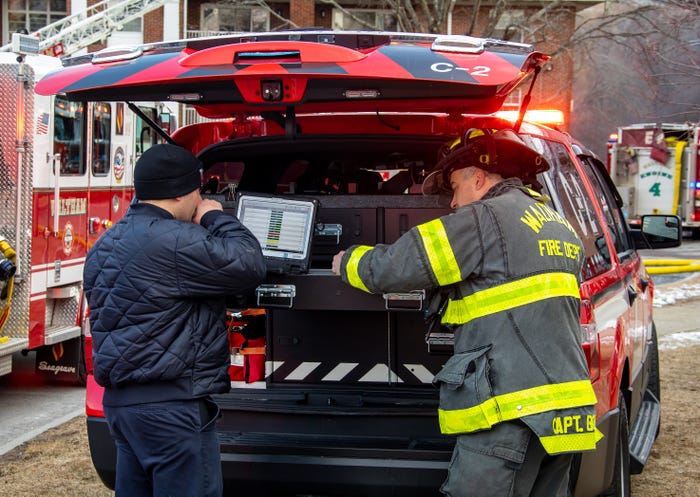Transmission lines: unravelling the mysteryTransmission lines: unravelling the mystery
As stated in January's "Technically Speaking," when a transmission line is terminated in its characteristic impedance, the line is non-resonant. The length
February 1, 2000
As stated in January’s “Technically Speaking,” when a transmission line is terminated in its characteristic impedance, the line is non-resonant. The length of a non-resonant line is not important, except when considering the attenuation of the desired signal between the transmitter and the antenna, or between the antenna and the receiver. The impedance anywhere along the line will be the same.
Standard system impedance In the land mobile radio field the standard impedance is 50ohm. Mobile radio transmitters and power amplifiers are designed to work into a 50ohm load impedance. Antennas are designed to present a 50ohm impedance to the transmission line. The coaxial cable that delivers power from the transmitter or amplifier to the antenna has a characteristic impedance of 50ohm.
In Figure 1 below, a 50ohm generator is connected to a 50ohm transmission line that is terminated in a load. If the impedance of the load is 50ohm (purely resistive), all of the power delivered to the load will be dissipated in the load. If the load impedance is anything other than 50ohm (purely resistive), power will be reflected back down the transmission line toward the source or generator.
If the impedance mismatch is a worst-case mismatch (open or short circuit), then all of the power delivered to the load will be reflected back down the line toward the source or generator. Thus, two traveling waves will be on the transmission line: a forward-traveling wave and a reflected-traveling wave. The forward traveling wave is often referred to as the incident wave. The phase relationship of the incident and reflected waves will vary along the length of the line.
Load mismatch
For this discussion, assume a lossless transmission line terminated with a purely resistive load of 150ohm. Let’s consider the voltage levels of the two waves. For this discussion, let’s assign 1.0V as the voltage of the incident wave. The voltage of the incident wave at the load will be 1.0V, but what about the voltage of the reflected wave at that point? We know that the VSWR will be 150 4 50 5 3:1. By using a unit called the reflection coefficient, we can determine the voltage of the reflected wave. Reflection coefficient can be determined from the VSWR by the formula:
Gamma = S – 1/S +1
where Gamma = reflection coefficient S = VSWR.
From this we can determine that the reflection coefficient is 0.5. If we multiply the voltage of the incident wave (1.0V) by the reflection coefficient, we find that the voltage of the reflected wave is 0.5V. When the load impedance is greater than the system impedance, the voltage of the reflected wave is in phase with the voltage of the incident wave at the load. It is the combination (vector sum) of the incident voltage and the reflected voltage that produces the standing wave voltage. Refer to Figure 2 on page 20. Because, in this case, the reflected and forward voltages are in phase at the load, the voltage of the standing wave at this point will be 1V + 0.5V = 1.5V.
Reflection coefficient also has an angle associated with it. This is the phase angle of the reflected wave as referenced to the incident wave. When the reflected wave is in phase, or 180 degrees out of phase with the incident wave, the resultant standing wave voltage is determined simply by either adding the two (for in phase) or subtracting the reflected voltage from the incident voltage (for 180degrees out of phase).
When the phase angle is other than 0degrees or 180degrees, we must add the two, using vectors to find the resultant voltage in the standing wave.
Reflection coefficient can also be determined easily from reflected- and forward-power measurements. Divide the reflected power by the forward power and find the square root of the result. For example, 100W forward power and 25W reflected power yields a ratio of 0.25. The square root of 0.25 is 0.5-the reflection coefficient.
Table 1 on page 22 shows the reflection coefficient, phase angle and resultant voltage of the standing wave for a purely resistive load of 150ohm in a 50ohm system. Figure 3 at the right graphs the standing wave using data in Table 1.
In the previous example, the load impedance was purely resistive and, at 150ohm, three times greater than the system impedance. Let’s examine a situation where the load impedance is less than (1/3) the system impedance, or 16.67V. Again, the VSWR will be 3:1, and the reflection coefficient will be 0.5. Table 2 on page 22 shows the data for reflection angle, voltage of standing wave (assuming a voltage level of 1V for the incident wave) and reflection coefficient at various distances from the load. Figure 4 at the right graphs the data from Table 2.
Compare Figures 3 and 4. When the load impedance is lower than the characteristic impedance of the transmission line, the voltages of the reflected and incident waves are 180 degrees out of phase at the load. This results in a voltage minima on the standing wave pattern. The voltage maxima will occur at a point a quarter wavelength (l/4) down the line and every l/2 from that point. This is the reverse of the condition where the load resistance is higher than the characteristic impedance of the line. In that case, the voltage of the standing wave is at a maxima at the load because the reflected and incident waves are in phase, producing a higher resultant voltage on the standing wave pattern.
The Smith chart has long been recognized as one of the most valuable tools invented for transmission line calculations. Next month we will examine a software version of the famous Smith chart. You might be surprised to learn that the Smith chart is not for RF design engineers only.
So, until next time-stay tuned!



